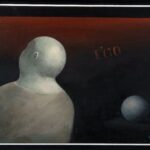
Kličius Galius
Born in 1950.
Student at the M.K.Čiurlionis Art School, studied at the Vilnius State Institute of Arts, specializing in theater artist.
Theater and film artist, set designer.
Member of the Lithuanian Artists’ Union, member of the Cinematographers’ Union.
Laureate of the State Prize (film “Faktas”, LKS, 1980).
1972-1975 – Artist – set designer of the Vilnius University Courtyard Theater.
1976-1978 – Artist-set designer of the State Youth Theater.
1978-1993 – Artist-set designer of the Lithuanian Film Studio.
Created set designs for 34 theater performances.
Artist of 19 film and television feature films.
Art director of 11 joint projects of Lithuanian and foreign companies filmed in Lithuania,
Artist of 4 foreign films.
Participated in scenography exhibitions in Vilnius, Riga, Prague (1997, 1981, 1983, 1985, 1989)
Began painting in oils in 1993, organized two personal exhibitions of paintings – in 1993 and 1994.
Galius Kličius, being perhaps the most famous artist of the Lithuanian film gold fund, only in recent years has he switched to his dream painting. Once, choosing scenography, he consoled himself that it was better to be the twentieth scenographer than the thousandth painter. But, apparently, he will not be destined to remain the thousandth either – next week, an exhibition of five Antanas Gudaitis Prize nominees opens in Vilnius, at the Pylimos Gallery, among whom is his name, a film and theater artist and scenographer.
G.Kličius considers it an honor to participate in such a competition, just as, he says, it is a great dishonor for the state to delay the construction of a gallery intended to exhibit paintings donated by A.Gudaitis until now. “I don’t know what else in Lithuania could compare this meter to. We cannot forget the artist who created a school of painting during the most difficult period, who produced and raised so many painters, who had so many followers, and whose tradition is still alive today.”
A.Gudaitis’ former student dismisses the rumors about the death of painting, saying that such an appearance is created by circumstances, because after conceptual art occupied the Contemporary Art Center, it is being pushed out to the galleries as an outsider. When divided into galleries, painting becomes less noticeable, has fewer chances to appear in all its strength and variety of styles, although Lithuania, like nowhere else, is full of interesting, far-advanced creators in this field.
He himself does not consider himself one of these, modestly adding that he has only been actively painting for five or six years, although those years seem to have been enough for him to attract the attention of not only art connoisseurs, but also collectors. “I am tormented,” says the artist, “that I was and still am a realist. After all, working in the theater or cinema constantly requires concreteness from an artist. I remember that we have already shown installations or performances, the things that conceptual art tries to surprise the viewer with, at scenography exhibitions, so I am no longer interested in returning to them, but returning to traditional painting was very interesting to me. I learned to draw and apply colors again. Although I feel that I am reaching another level, I am still very far from the desired result. I would not dare to relax or say that I have found my style yet. Although it seems to others that it is there, you can still see connections and influences: I was friends with Raimundas Sližis, whose style I really liked, and with Adomas Jacovskis, I graduated from the Academy of Arts together. Sometimes I think that I was lucky enough to study with such masters of art as A. Gudaitis, Augustinas Savickas, with such masters like Vladas Karatajus, at the M.K. Čiurlionis Art School – Vytautas Ciplijauskas, Vincas Kisarauskas, Aloyzas Stasiulevičius, Valentinas Antanavičius (I had a lot of the most interesting teachers), I lost a lot of time – if I had painted all the time, maybe the outlines of my painting would be different now”.
Sometimes, when dissatisfied, Galius would repaint his paintings. This happened to Patriot, who attracted attention at one of the artist’s exhibitions. Such a sad lonely man in a boat with a tricolor in his hand. “It seemed to me that the figure was dull, I wanted to enliven its colors”, – he explains.
He probably inherited the artist’s vein from his mother. She used to decorate the walls of the apartment with pictures, one of which, painted by some artist in 1912, now hangs in G. Kličius’ house. When he undertook to reframe it, it turned out that a French menu was drawn on the other side… Galius’ mother Aleksandra had graduated from Vytautas Magnus University with a degree in Lithuanian studies, left Kaunas for Central Asia during the war, worked in an orphanage, and upon her return became an employee of the Ministry of Education and supervised the orphanage. Apparently, she was a talented woman, because at that time she created very interesting paintings that were unusual for that time: she would paint applications with gouache, chalk, and pastel. “Once, maybe in 1960 or 1961, three of her paintings were displayed in an art salon near the Cathedral, and she priced them at three or five rubles. That alone made them dissonant with those for which they were asked to pay a thousand or even more; I remember someone criticized her in the “Literature and Art” newspaper at the time,” says G. Kličius… “I have been preparing to see if the university’s
“…there is one of my mother’s works left in the library, which was handed over after her death.”
His father, it seems, had nothing to do with the arts: he was wounded fighting in the 16th Lithuanian Division during the war; he headed the Lithuanian Land Reclamation Service. He also, he remembers, was the director of the Agricultural Technical School, where the Russian Embassy is now located. He lost him when he was five. He remembers that he was fed in the place where the Presidential Palace is now, in a hall called the White Hall.
It is possible to joke sadly that the collapse of the Film Studio was the evil that worked for G. Kličius. Maybe (as blasphemous as it sounds) it worked for us too, because we would not know what kind of painter he was. We had the opportunity to get to know him at as many as five personal exhibitions.
The artist still cannot calmly mention the collapse of the Film Studio, and the conviction that it was a sanctioned destruction of culture only grows stronger. “It was It’s sad, he says, when you suddenly feel alone, as if you’re not really needed, as if you’re not really invited anywhere… On the other hand, the moment has come that you’ve been waiting for. Until then, you worked in a team, moved at a normal pace, thinking little about painting. You remembered the past, but only the past. There was no time. You wouldn’t find a theater in Lithuania for whose performance I wouldn’t have created scenography, well, maybe except for the puppet theater in Kaunas. I started making friends with the stage since my studies, when a group of friends and I started putting on performances ourselves. After graduating from the institute, I started working at the university’s Kiemos Theater, where I transferred the style of the Art Institute (only in those performances where I directed myself). It was a bit of a stir at the time when we showed “Navickiad”, 3 episodes. Then they closed us down. Later, I staged “Pakeleivingus” and “Kitais matai” based on J. Erlickas at the Old Town Theater. It was the most beautiful and fun time of my youth.”
G.Kličius spent the longest time in cinema. “It’s not for nothing,” he says, “that everyone who immerses themselves in cinema drowns in it. Having immersed themselves in painting, G.Kličius does not renounce either cinema or theatre altogether. Right now, at the Alytus Theatre, he is again creating scenography for a play based on J.Erlickas, based on the work of this writer, the show “Inteligentai” was broadcast on Lithuanian television last year, where his hand was also involved. He does not refuse to work in Šiauliai, at the Naisiai Theatre, which impresses him with the fact that it not only popularizes Lithuanian dramaturgy, but also takes it to parishes for free, bringing it close to people.
Likes to laugh, G. Kličius says that he is sadder in painting: “Here I meet myself, here I walk my own way of the cross. Of course, you walk them in cinema and theater, but here you have to walk them alone.”
Awards
The work of Galius Kličius as a film and theater artist and set designer has received due recognition: both in the Soviet era, when he was awarded the State Prize, and this year, when he, together with several lucky ones, was awarded the Government Prize. The “Silver Crane” award was awarded to the works of this creator in two contemporary films: “The Incantation of Sin” (directed by Algimantas Puipa) and “When I Embrace You” (directed by Kristijonas Vildžiūnas), although he is more sympathetic to his own contribution to the Soviet-era films “Eternal Light”, “And the Shores Are Sandy” (directed by A.Puipa), “Fact” (directed by Almantas Grikevičius and Vytautas Žalakevičius), “Summer Ends in Autumn” (directed by Gytis Lukšas), when films were made “with money” and without haste, when professionalism meant almost everything. While the Lithuanian Film Studio was still in its infancy, foreign film companies were also happy to use the services of the professional G.Kličius.
Prepared according to the daily “Respublika”


